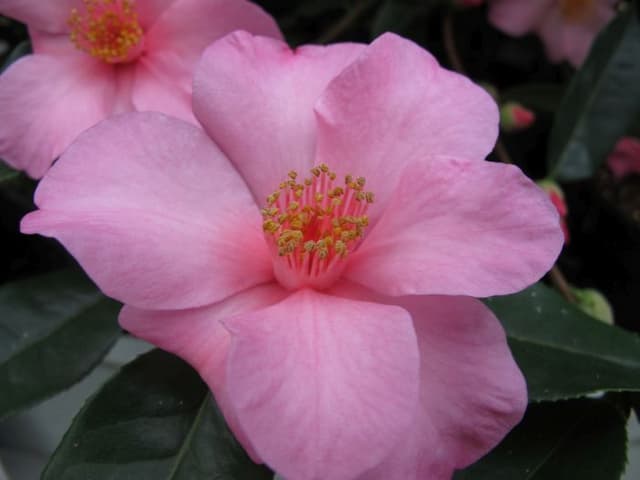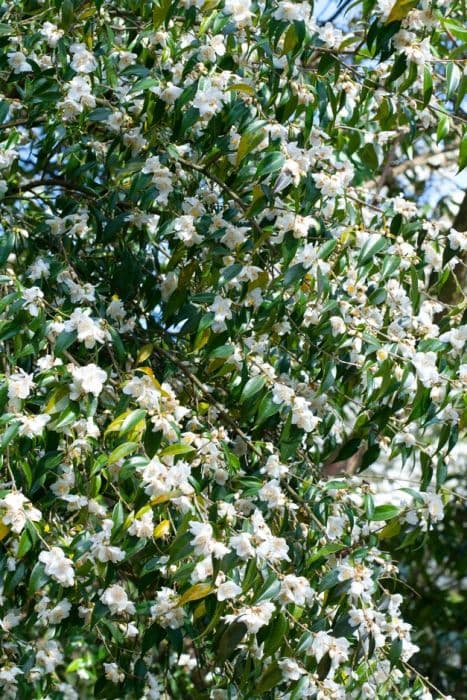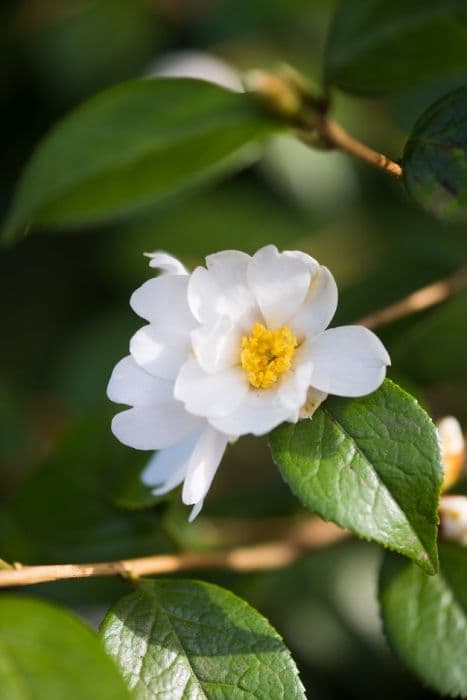Japanese camellia Camellia japonica 'Nobilissima'

ABOUT
The Camellia japonica 'Nobilissima', commonly known as the Japanese camellia, is a stunning ornamental plant celebrated for its gorgeous blooms. This variety is notable for its large, ruffled flowers that are a rich creamy white. Each blossom exudes an elegant simplicity and may have a hint of ivory to pale yellow at their centers which adds to their allure. The petals are layered in a symmetrical fashion, giving the flowers a very full, classic camellia look that can be quite eye-catching in the garden. The Japanese camellia boasts glossy, dark green leaves that are oval-shaped with a smooth texture, providing a lush backdrop for the striking flowers. The leaves have a leathery feel, with a slight serration at the edges, and form a dense, evergreen foliage that remains attractive throughout the year. The overall appearance of the plant is one of elegance and sophistication, with its luxurious blossoms standing out beautifully against the deep green foliage. The plant's structure is well-branched and can provide a sense of volume even without reference to its specific dimensions. As a cultivated ornamental, this Japanese camellia's blooms appear during the late winter to early spring months, offering a burst of brightness during a time when many other plants are dormant. This trait makes it especially valuable for gardeners looking to maintain year-round interest in their landscapes. The allure of its flowers and evergreen presence combine to make the Japanese camellia 'Nobilissima' a highly desirable plant for ornamental display.
About this plant
 Names
NamesFamily
Theaceae
Synonyms
Japanese Camellia, Rose of Winter
Common names
Camellia japonica 'Nobilissima'.
 Toxicity
ToxicityTo humans
The Japanese camellia (Camellia japonica 'Nobilissima') is generally not considered toxic to humans. Ingesting parts of this plant is unlikely to cause serious poisoning. There have been no significant reports of illness or toxicity after consuming the leaves or flowers of the Japanese camellia. However, it is always advisable not to consume any part of ornamental plants due to potential individual allergic reactions or gastrointestinal discomfort.
To pets
The Japanese camellia (Camellia japonica 'Nobilissima') is also generally not considered toxic to pets. It is not listed among the common toxic plants for pets such as dogs and cats. Ingesting parts of this plant should not cause serious health problems. However, individual animals could have sensitivity leading to mild gastrointestinal upset if they ingest plant material. As with humans, it’s best to prevent pets from consuming non-food plants to avoid any potential issues.
 Characteristics
CharacteristicsLife cycle
Perennials
Foliage type
Evergreen
Color of leaves
Green
Flower color
White
Height
6-10 feet (1.8-3 meters)
Spread
6-10 feet (1.8-3 meters)
Plant type
Shrub
Hardiness zones
7
Native area
Japan
Benefits
 General Benefits
General Benefits- Aesthetic appeal: The Camellia japonica 'Nobilissima' offers beautiful, large white flowers that enhance the visual appeal of any garden or landscape.
- Year-round interest: With its glossy evergreen foliage, the Camellia provides color and texture throughout all seasons, even in winter.
- Shade tolerance: This plant is well-suited for shaded areas in the garden where many other plants may not thrive.
- Habitat for wildlife: Camellias can provide shelter and sometimes food for various species of birds and beneficial insects.
- Privacy screening: The dense growth habit of Camellia japonica 'Nobilissima' makes it a good choice for privacy hedges or screens.
- Long blooming period: Unlike some other plants, Camellias typically have a long flowering period from late winter into spring.
- Versatility in the landscape: The Camellia can be used in various ways in landscape design, including as a specimen plant, in borders, and as container plants.
- Durability: Once established, Camellias are relatively hardy and can withstand some challenging conditions, including minor droughts.
- Cultural significance: Camellias have a rich history and cultural importance in many countries, especially in East Asian horticulture and art.
- Minimal pest problems: Camellias are generally resistant to a lot of pests that commonly plague other garden plants.
 Medical Properties
Medical PropertiesThis plant is not used for medical purposes.
 Air-purifying Qualities
Air-purifying QualitiesThis plant is not specifically known for air purifying qualities.
 Other Uses
Other Uses- Artistic Inspiration: Camellia can serve as a muse for artists and photographers due to its vibrant and structured flowers, potentially leading to creative works and garden photography.
- Culinary Garnish: The petals of Camellia flowers can be used as an edible decoration to add elegance to fine dishes, although they should be ensured free of pesticides and safe for consumption beforehand.
- Dye Production: The petals of the Camellia can be used to create natural dyes for fabrics or art projects, providing a range of pink and red hues.
- Religious Ceremonies: In some cultures, Camellia flowers are used in religious rituals and ceremonies as symbols of divine beauty or seasonal transitions.
- Bath Additive: Camellia petals can be floated in a bath for an aromatic and visually appealing experience, often used in spas for their beauty and mild fragrance.
- Bookmark Creation: Dry Camellia petals can be laminated to create floral bookmarks, offering a touch of nature to one's reading experience.
- Floral Crafts: The flowers and leaves of the Camellia can be used in making wreaths, floral arrangements, or potpourri, particularly popular for festive decorations.
- Paper Making: Camellia petals can be incorporated into homemade paper to create textured and decorative sheets for stationery or art projects.
- Wedding Confetti: Dried Camellia petals can serve as biodegradable wedding confetti, providing an eco-friendly alternative to traditional rice or synthetic confetti.
- Fashion Accessories: Fresh or dried Camellia flowers can be used to create hair accessories, brooches, or other wearable floral decor for special occasions or creative fashion statements.
Interesting Facts
 Feng Shui
Feng ShuiThe Camellia is not used in Feng Shui practice.
 Zodiac Sign Compitability
Zodiac Sign CompitabilityThe Camellia is not used in astrology practice.
 Plant Symbolism
Plant Symbolism- Admiration: The camellia flower is often associated with admiration and is given as a gift to express one's esteem or respect for someone else.
- Perfection: With its lush, perfectly arranged petals, the camellia represents the ideal of perfection and excellence.
- Love: Different colors of camellia flowers convey different messages of love. The camellia japonica 'Nobilissima', with its white petals, can symbolize adoration or a deep, enduring love.
- Longevity and Gratitude: Camellias have a long blooming season, which can symbolize the enduring nature of life and express gratitude for someone's presence.
- Refinement: Due to its beautiful form and association with noble circles, the camellia is a symbol of refinement and sophistication.
 Water
WaterJapanese Camellia should be watered deeply and thoroughly to ensure that the soil is moist but not waterlogged. During active growth periods, typically spring and summer, watering may be required once or twice a week depending on weather conditions. In general, aim to provide up to 1 gallon of water per week during dry spells; however, be sure to reduce the frequency in winter when the plant is dormant. Always check the top few inches of soil for dryness before watering to avoid over-watering, as excessive moisture can lead to root rot.
 Light
LightJapanese Camellia thrives in partial shade to light dappled sunlight. The best spot for the plant would protect it from the hot afternoon sun, which can be too intense and may scorch the leaves. An ideal location would provide morning sun with afternoon shade, ensuring the plant gets the light it needs without the heat stress.
 Temperature
TemperatureJapanese Camellia is a hardy plant that prefers cooler temperatures and can typically survive in temperatures as low as 20 degrees Fahrenheit but not below 10 degrees Fahrenheit. The ideal temperature range for the plant is between 60 to 70 degrees Fahrenheit. Japanese Camellias should be protected from frost and cold winds, which can damage flower buds and foliage.
 Pruning
PruningJapanese Camellia should be pruned to maintain shape, remove dead or weak branches, and promote healthy growth. The best time for pruning is just after blooming ends in the spring, which allows time for new buds to form for the next season. Pruning every year or two is typically sufficient, focusing on thinning out crowded branches to enhance air circulation and light penetration.
 Soil
SoilJapanese camellia thrives in acidic soil with a pH between 5.5 to 6.5; the best soil mix is a combination of peat moss, perlite, and pine bark, which ensures good drainage and maintains moisture without waterlogging.
 Repotting
RepottingJapanese camellias should be repotted every 2-3 years in the spring, but mature, large plants can be repotted less frequently, about every 4-5 years or as needed.
 Humidity & Misting
Humidity & MistingJapanese camellia prefers high humidity levels, ideally between 50% to 60%, which can be maintained through regular misting or using a humidifier when grown indoors.
 Suitable locations
Suitable locationsIndoor
Place in bright, indirect light and keep evenly moist.
Outdoor
Plant in dappled shade with shelter from strong winds.
Hardiness zone
7-9 USDA
 Life cycle
Life cycleThe Japanese Camellia 'Nobilissima' begins its life as a seed, which will germinate in favorable conditions of warmth and moisture, typically in late winter or early spring. After sprouting, the seedling grows into a young plant with a taproot system, and over several years, it will develop into a mature shrub with glossy, evergreen leaves. The plant then enters a phase of vegetative growth, during which time it invests energy into growing in size and strength. Once mature, usually within 2 to 5 years, 'Nobilissima' starts its reproductive stage, producing large, fragrant, white flowers with yellow centers from late winter to spring. These flowers are pollinated by insects, after which the plant produces seed-filled fruit, thereby completing its reproductive cycle. The Japanese Camellia 'Nobilissima' can live for many years, reaching a mature size of up to 12 feet tall, and will continue to go through cycles of growth and reproduction throughout its life.
 Propogation
PropogationPropogation time
Early Spring
Propogation: The best time to propagate Camellia japonica 'Nobilissima', also known as Japanese camellia, is typically in the late summer to early fall when the plant is no longer actively growing and the new shoots have matured. The most popular method for propagating this camellia is through semi-hardwood cuttings. To do this, select healthy shoots from the current year's growth and cut a 4 to 6 inch (10 to 15 cm) section, ensuring each cutting has at least two to three sets of leaves. Remove the bottom leaves and dip the cut end in a rooting hormone to encourage growth. Plant the cutting in a pot filled with a mixture of peat and perlite or a similar well-draining rooting medium. Cover the pot with a plastic bag to maintain humidity and place it in a warm, well-lit area, but out of direct sunlight. With proper care, the cuttings typically root within several weeks to a few months.









